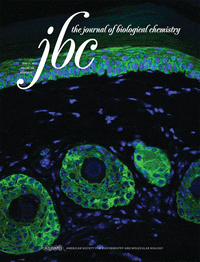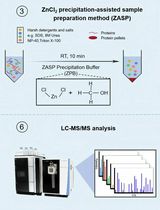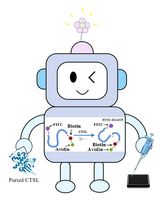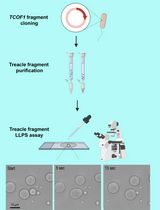- EN - English
- CN - 中文
Active Cdk5 Immunoprecipitation and Kinase Assay
活性Cdk5免疫沉淀及其激酶活性的测定
发布: 2017年07月05日第7卷第13期 DOI: 10.21769/BioProtoc.2363 浏览次数: 10023
评审: Pengpeng LiLiang LiuAnonymous reviewer(s)
Abstract
Cdk5 activity is regulated by the amounts of two activator proteins, p35 and p39 (Tsai et al., 1994; Zheng et al., 1998; Humbert et al., 2000). The p35-Cdk5 and p39-Cdk5 complexes have differing sensitivity to salt and detergent concentrations (Hisanaga and Saito, 2003; Sato et al., 2007; Yamada et al., 2007; Asada et al., 2008). Cdk5 activation can be directly measured by immunoprecipitation of Cdk5 with its bound activator, followed by a Cdk5 kinase assay. In this protocol, buffers for cell lysis and immunoprecipitation are intended to preserve both p35- and p39-Cdk5 complexes to assess total Cdk5 activity. Cells are lysed and protein concentration is determined in the post-nuclear supernatant. Cdk5 is immunoprecipitated from equal amounts of total protein between experimental groups. Washes are then performed to remove extraneous proteins and equilibrate the Cdk5-activator complexes in the kinase buffer. Cdk5 is then incubated with histone H1, a well-established in vitro target of Cdk5, and [γ-32P]ATP. Reactions are resolved by SDS-PAGE and transferred to membranes for visualization of H1 phosphorylation and immunoblot of immunoprecipitated Cdk5 levels. We have used this assay to establish p39 as the primary activator for Cdk5 in the oligodendroglial lineage. However, this assay is amenable to other cell lineages or tissues with appropriate adjustments made to lysis conditions.
Keywords: Kinase assay (激酶活性测定)Background
Although Cdk5 is typically associated with neuronal function, recent work has demonstrated that Cdk5 also regulates oligodendroglia progenitor cell (OPC) development (Tang et al., 1998; Miyamoto et al., 2007 and 2008). Cdk5 function is critical for OPC migration and differentiation, and loss of Cdk5 results in CNS hypomyelination (Miyamoto et al., 2007 and 2008; He et al., 2010; Yang et al., 2013). However, molecular mechanisms that regulate Cdk5 function in neurons and OLs remain elusive. The activity of Cdk5 is controlled by the available amounts of two activator homologs, p35 and p39 (Tsai et al., 1994; Zheng et al., 1998; Humbert et al., 2000). The defects in embryonic brain development and perinatal lethality observed in mice lacking both p35 and p39 were nearly identical to defects in the Cdk5-null mice (Ohshima et al., 1996; Ko et al., 2001), indicating that p35 and p39 are the sole activators of Cdk5 in the brain. We uncovered that in contrast to the major role of p35 in activating Cdk5 in neurons, p39 is the primary Cdk5 activator in oligodendrocytes (OLs), where p35 expression is negligible. Using this active Cdk5 immunoprecipitation and kinase assay, we demonstrated that Cdk5 activity is almost completely ablated in OLs with siRNA-mediated p39 knockdown. Previous work established the differing sensitivity of p35 and p39 to high detergent and salt concentrations (Hisanaga and Saito, 2003; Sato et al., 2007; Yamada et al., 2007; Asada et al., 2008). Based on those reports, this protocol was developed to try and preserve both p35- and p39-Cdk5 complexes to measure total Cdk5 activity regardless of activator. Our work further showed that p39 is essential for OL differentiation and myelin repair, with upregulation of p35 masking the loss of p39 function during myelin development. Measuring Cdk5 activity from cells, in combination with immunoblots for Cdk5 target phosphorylation, provides a tool to identify novel regulators of Cdk5 activation.
Materials and Reagents
- Cell lifter (Corning, catalog number: 3008 )
- Corning sterile 60 mm cell culture dishes (Corning, catalog number: 3261 )
- Corning sterile 100 mm cell culture dishes (Corning, catalog number: 3262 )
- 15 ml conical tubes (Denville Scientific, catalog number: C1018-P )
- Micro slides (Thermo Fisher Scientific, Thermo ScientificTM, catalog number: 4951PLUS4 )
- Micro cover glass (Thermo Fisher Scientific, Thermo ScientificTM, catalog number: 25X54I24901 )
- 1.7 ml tubes (Denville Scientific, SlipTechTM, catalog number: C19033 )
- 50 ml conical tubes (Denville Scientific, catalog number: 1005513 )
- Nitrocellulose or PVDF membrane (GE Healthcare, catalog number: RPN82D or 10600021 )
- Autoclaved micropipette tips (Denville Scientific, Woodpecker ReloadsTM, catalog numbers: P2102-NB , P2101-N , P2109 )
- X-ray film (Denville Scientific, Hyblot ES®, catalog number: E3218 )
- Trypan blue (Sigma-Aldrich, catalog number: 302643 )
- BCA Kit (Thermo Fisher Scientific, Thermo ScientificTM, catalog number: 23235 )
- Bovine serum albumin (BSA) (Sigma-Aldrich, catalog number: A2153 )
- Antibody against Cdk5 (Santa Cruz C-8) (Santa Cruz Biotechnology, catalog number: sc-173 )
- Antibody against Cdk5 (Cell Signaling Technology, catalog number: 2506 )
- Rabbit IgG antibody (Vector Laboratories, catalog number: I-1000 )
- Goat anti-rabbit-horseradish peroxidase (HRP) (Jackson ImmunoResearch, catalog number: 111-035-003 )
- 10 mM ATP (Thermo Fisher Scientific, catalog number: PV3227 )
- Cdk5/p25, active complex (EMD Millipore, catalog number: 14-516 )
- [γ-32P]ATP (PerkinElmer, catalog number: BLU002Z250UC )
- Histone H1 (EMD Millipore, catalog number: 14-155 )
- 12% polyacrylamide gel (Bio-Rad Laboratories, catalog number: 4561043 )
- Enhanced Chemiluminescence Reagent Kit (Thermo Fisher Scientific, Thermo ScientificTM, catalog number: 32106 )
- Tris/Glycine/SDS buffer (Bio-Rad Laboratories, catalog number: 1610732 )
- Methanol (Sigma-Aldrich, catalog number: 34860 )
- Sodium phosphate dibasic (Na2HPO4) (Sigma-Aldrich, catalog number: S7907 )
- Potassium phosphate monobasic (KH2PO4) (Sigma-Aldrich, catalog number: P5655 )
- Potassium chloride (KCl) (Sigma-Aldrich, catalog number: P9333 )
- Sodium chloride (NaCl) (Sigma-Aldrich, catalog number: S7653 )
- Tris base (Sigma-Aldrich, catalog number: RDD008 )
- Concentrated HCl (Sigma-Aldrich, catalog number: 295426 )
- Ethylenediaminetetraacetic acid (EDTA) (Sigma-Aldrich, catalog number: EDS )
- Sodium hydroxide (NaOH) tablets (Sigma-Aldrich, catalog number: S8045 )
- Ethylene glycol-bis(β-aminoethyl ether)-N,N,N’,N’-tetraacetic acid (EGTA) (Sigma-Aldrich, catalog number: E3889 )
- 3-(N-morpholino)propanesulfonic acid (MOPS) (Sigma-Aldrich, catalog number: RDD003 )
- Magnesium chloride (MgCl2) (Sigma-Aldrich, catalog number: M8266 )
- Sodium fluoride (NaF) (Sigma-Aldrich, catalog number: S7920 )
- NP-40/IGEPAL® CA-630 (Sigma-Aldrich, catalog number: I3021 )
- Polymethyl sulfonyl fluoride (PMSF) (Sigma-Aldrich, catalog number: P7626 )
- 100% ethanol (Sigma-Aldrich, catalog number: E7023 )
- Pepstatin (Sigma-Aldrich, catalog number: P4265 )
- Leupeptin (Sigma-Aldrich, catalog number: L2884 )
- Aprotinin (Sigma-Aldrich, catalog number: A1153 )
- Protein A Sepharose CL-4B (GE Healthcare, catalog number: 17-0780-01 )
- Pre-activated sodium orthovanadate (100 mM Na3VO4) (New England Biolabs, catalog number: P0758L )
- 10% BrijTM-35 (Thermo Fisher Scientific, Thermo ScientificTM, catalog number: 28316 )
- Glycerol (Sigma-Aldrich, catalog number: G5516 )
- 2-mercaptoethanol (Sigma-Aldrich, catalog number: M6250 )
- Magnesium acetate (MgOAc) (Sigma-Aldrich, catalog number: M5661 )
- Tween-20 (Sigma-Aldrich, catalog number: P1379 )
- Bromophenol blue (Sigma-Aldrich, catalog number: B0126 )
- 1x transfer buffer (see Recipes)
- 10x phosphate-buffered saline (PBS) (see Recipes)
- 1x phosphate-buffered saline (PBS) (see Recipes)
- 2 M Tris-HCl (pH 7.5) (see Recipes)
- 50 mM Tris-HCl (pH 7.5) (see Recipes)
- 5 M NaCl (see Recipes)
- 0.5 M EDTA (pH 8.0) (see Recipes)
- 0.5 M EGTA (pH 8.0) (see Recipes)
- 1 M MOPS (pH 7.0) (see Recipes)
- 1 M MgCl2 (see Recipes)
- 1 M NaF (see Recipes)
- 20% NP-40 (see Recipes)
- 100 mM PMSF (see Recipes)
- 1 mg/ml pepstatin A (see Recipes)
- 1 mg/ml leupeptin (see Recipes)
- 1 mg/ml aprotinin (see Recipes)
- 50% slurry of Protein A Sepharose CL-4B (see Recipes)
- Cdk5 lysis buffer (stock) (see Recipes)
- Cdk5 lysis buffer (working) (see Recipes)
- Cdk5 kinase buffer (stock) (see Recipes)
- Cdk5 kinase buffer (washes) (see Recipes)
- Cdk5 kinase buffer (assay) (see Recipes)
- MOPS dilution buffer (see Recipes)
- 5x reaction buffer (see Recipes)
- 50 mM magnesium acetate buffer (MgOAc) (see Recipes)
- 1x phosphate-buffered saline/0.1% Tween-20 (PBS-T) (see Recipes)
- 5x Laemmli buffer (see Recipes)
- 0.2% bromophenol blue (see Recipes)
Equipment
- Hemacytometer (Hausser Scientific, catalog number: 3100 )
- PIPETMAN ClassicTM pipets (Gilson, model: P10, catalog number: F144802 )
- PIPETMAN ClassicTM pipets (Gilson, model: P20, catalog number: F123600 )
- PIPETMAN ClassicTM pipets (Gilson, model: P200, catalog number: F123601 )
- PIPETMAN ClassicTM pipets (Gilson, model: P1000, catalog number: F123602 )
- Refrigerated tabletop centrifuge for 15 ml conical tubes (Jouan, model: CT422 )
- Tabletop centrifuge for 1.5 ml tubes in a 4 °C cold room (Eppendorf, model: 5415 D )
- Inverted light microscope (Olympus, model: CK30 )
- Certified Geiger counter (W.B. Johnson Instruments, model: GSM-110 )
- Plexiglass shielding (Thermo Fisher Scientific, Thermo ScientificTM, catalog number: 6700-1812 )
- Phosphorimaging cassette (Thomas Scientific, catalog number: C993J84)
Manufacture: bioWORLD, catalog number: 43121008-1 . - Autoradiography cassette (Denville Scientific, catalog number: E3122 )
- 500 ml glass bottles (Corning, PYREX®, catalog number: 1397-500 )
Software
- GraphPad Prism (GraphPad Software)
- ImageJ (https://imagej.nih.gov/ij)
Procedure
文章信息
版权信息
© 2017 The Authors; exclusive licensee Bio-protocol LLC.
如何引用
Readers should cite both the Bio-protocol article and the original research article where this protocol was used:
- Bankston, A. N., Ku, L. and Feng, Y. (2017). Active Cdk5 Immunoprecipitation and Kinase Assay. Bio-protocol 7(13): e2363. DOI: 10.21769/BioProtoc.2363.
- Bankston, A. N., Li, W., Zhang, H., Ku, L., Liu, G., Papa, F., Zhao, L., Bibb, J. A., Cambi, F., Tiwari-Woodruff, S. K. and Feng, Y. (2013). p39, the primary activator for cyclin-dependent kinase 5 (Cdk5) in oligodendroglia, is essential for oligodendroglia differentiation and myelin repair. J Biol Chem 288(25): 18047-18057.
分类
生物化学 > 蛋白质 > 分离和纯化
您对这篇实验方法有问题吗?
在此处发布您的问题,我们将邀请本文作者来回答。同时,我们会将您的问题发布到Bio-protocol Exchange,以便寻求社区成员的帮助。
Share
Bluesky
X
Copy link













